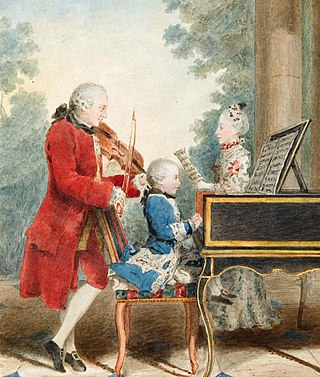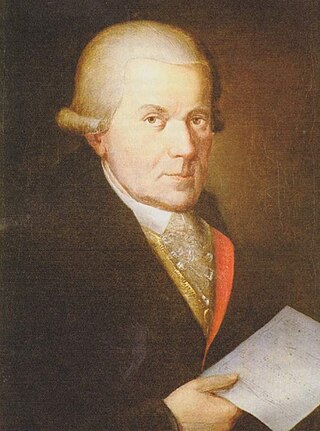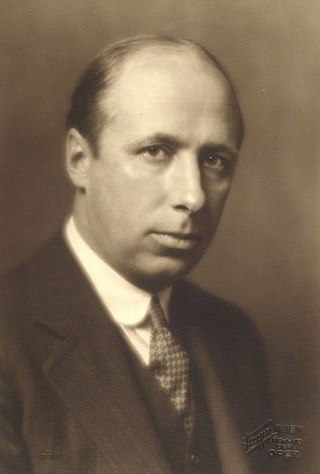External links
| Topics | |||||||||||
|---|---|---|---|---|---|---|---|---|---|---|---|
| Lists of works | |||||||||||
| Other works | |||||||||||
| People |
| ||||||||||
| Namesakes | |||||||||||
| Related | |||||||||||
The Hoboken catalogue is a catalogue of the musical compositions by Joseph Haydn compiled by Anthony van Hoboken. It is intended to cover the composer's entire oeuvre and includes over 750 entries. Its full title in the original German is Joseph Haydn, Thematisch-bibliographisches Werkverzeichnis ("Joseph Haydn, thematic-bibliographic catalogue of works"). The Haydn catalogue that now bears Hoboken's name was begun in card format in 1934; work continued until the publication of the third and final book volume in 1978.
Works by Haydn are often indicated using their Hoboken catalogue number, typically in the format "Violin Concerto No. 1 in C major, Hob. VIIa:1".
The catalogue is a massive work; a currently available version runs to 1936 pages. [1] Each work is given with an identifying incipit, printed on a single musical line. There is discussion of manuscript sources, early editions, listing in previous catalogues (including the two Haydn prepared), and critical commentary.
Catalogues of composers' works typically follow either a chronological arrangement (sorting by date of composition) or a sorting by musical genre. [2] Hoboken's catalogue is of the latter type; thus the symphonies, for example, are in category I, all string quartets are in category III, piano sonatas are in category XVI, and so on.
| Hob. | Category |
|---|---|
| I | Symphonies (1–108) |
| Ia | Overtures (1–17) |
| II | Divertimenti in 4 and more Parts (1–47) |
| III | String Quartets (1–83) |
| IV | Divertimenti in 3 Parts (1–11) |
| V | String Trios (1–21) |
| VI | Various Duos (1–6) |
| VII | Concertos for Various Instruments |
| VIII | Marches (1–7) |
| IX | Dances (1–31) |
| X | Various Works for Baryton (1–12) |
| XI | Trios for Baryton, Violin (or Viola) and Cello (1–126) |
| XII | Duos with Baryton (1–24) |
| XIII | Concertos for Baryton (1–3) |
| XIV | Divertimenti with Piano (1–13) |
| XV | Trios for Piano, Violin (or Flute) and Cello (1–41) |
| XVa | Piano Duos (1–3) |
| XVI | Piano Sonatas (1–52) |
| XVII | Piano Pieces (1–12) |
| XVIIa | Piano 4 Hands (1–2) |
| XVIII | Keyboard Concertos (1–11) |
| XIX | Pieces for musical clock (Flötenuhr) (1–32) |
| XX | Versions of The Seven Last Words of Christ (1–4) |
| XXa | Stabat Mater |
| XXI | Oratorios (1, 2, 3) |
| XXII | Masses (1–14) |
| XXIIa | Requiem |
| XXIIb | Libera me |
| XXIII | Other Sacred Works |
| XXIV | Cantatas and Arias with Orchestra |
| XXV | Songs with 2 (2), 3 (5), and 4 (9) Parts |
| XXVI | Lieder with Piano and Cantatas with Instruments |
| XXVII | Canons (Sacred 1–10; Secular 1–47) |
| XXVIII | Operas (1–13) |
| XXIX | Marionette Operas and Singspiele |
| XXX | Incidental Music (1–5) |
| XXXI | Arrangements of Scottish (273) and Welsh (61) and other (17) Folksongs |
| XXXII | Pasticcios (1–4) |

The Classical period was an era of classical music between roughly 1750 and 1820.

Franz Joseph Haydn was an Austrian composer of the Classical period. He was instrumental in the development of chamber music such as the string quartet and piano trio. His contributions to musical form have led him to be called "Father of the Symphony" and "Father of the String Quartet".

The term string quartet can refer to either a type of musical composition or a group of four people who play them. Many composers from the mid-18th century onwards wrote string quartets. The associated musical ensemble consists of two violinists, a violist, and a cellist.
In music, the opus number is the "work number" that is assigned to a musical composition, or to a set of compositions, to indicate the chronological order of the composer's publication of that work. Opus numbers are used to distinguish among compositions with similar titles; the word is abbreviated as "Op." for a single work, or "Opp." when referring to more than one work. Opus numbers do not necessarily indicate chronological order of composition. For example posthumous publications with opus numbers are often applied to a composers juvenalia and numbered as some of the final opus numbers, even though they may be some of the composers first completed works.

Johann Michael Haydn was an Austrian composer of the Classical period, the younger brother of Joseph Haydn.

Symphony No. 22 in E♭ major, Hoboken I/22, is a symphony written by Joseph Haydn in 1764, under the auspices of the benign Prince Nikolaus Esterházy. Its nickname is "The Philosopher".

Anthony van Hoboken was a Dutch musical collector, bibliographer, and musicologist. He became especially well known for his scholarship on the music of Joseph Haydn and in particular for being the creator of the Hoboken catalogue, the standard scholarly catalogue of Haydn's works.

Otto Erich Deutsch was an Austrian musicologist. He is known for compiling the first comprehensive catalogue of Franz Schubert's compositions, first published in 1951 in English, with a revised edition published in 1978 in German. It is from this catalogue that the D numbers used to identify Schubert's works derive.

Missa in tempore belli is a setting of the mass by Joseph Haydn. It is catalogued Mass No. 10 in C major. Known also as the Paukenmesse due to the dramatic use of timpani, it is one of the most popular of his fourteen mass settings. The autograph manuscript contains the title "Missa in tempore belli" in Haydn's handwriting.

Joseph Haydn's Symphony No. 27 in G major was probably written before March 19, 1761, while he was employed by Count Morzin. Its chronological position was assigned by Eusebius Mandyczewski in 1907. Although later adopted by Hoboken, Robbins Landon has subsequently revised the work's likely chronological position and now believes that the symphony is one of Haydn's earliest, written at roughly the same time as symphonies nos. 15–18. Haydn himself may have labeled the symphony his 16th, although this remains unclear.
This article gives an overview of various catalogues of classical compositions that have come into general use.